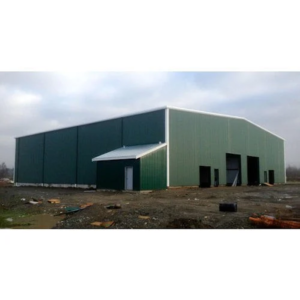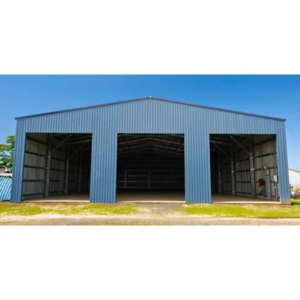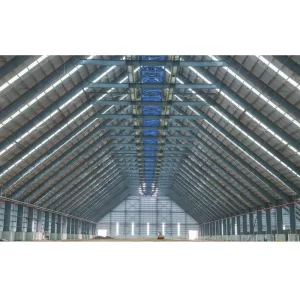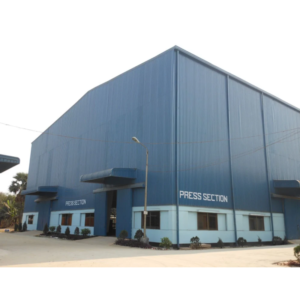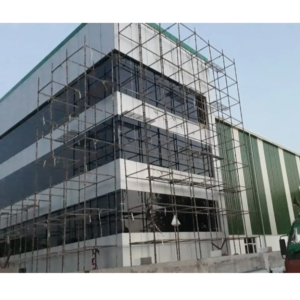Prefabricated Buildings
Prefabricated Buildings: The Future of Construction
Introduction to Prefabricated Buildings
In an era where efficiency, sustainability, and cost-effectiveness are paramount, prefabricated buildings have emerged as a revolutionary solution in the construction industry. Prefabricated buildings, also known as modular buildings, are structures that are manufactured off-site in a factory setting, then transported and assembled on-site. This innovative approach to construction offers numerous advantages over traditional building methods, making it an attractive option for residential, commercial, and industrial applications.
In this comprehensive guide, we will explore the different types of prefabricated buildings, their benefits, key features to consider, installation processes, and answers to frequently asked questions.
What are Prefabricated Buildings?
Prefabricated buildings are structures that are constructed from pre-made components manufactured in a controlled environment. These components include walls, floors, and roofs that are built in sections and then transported to the final construction site for assembly. This method of construction can significantly reduce construction time and labor costs while improving quality and reducing waste.
Key Features of Prefabricated Buildings
- Modular Design: Prefabricated buildings can be designed in modules, allowing for easy customization and expansion as needed.
- Quick Assembly: The off-site construction process means that assembly on-site can occur rapidly, often within days or weeks.
- High Quality Control: Components are manufactured in a controlled environment, ensuring consistent quality and adherence to safety standards.
- Energy Efficiency: Many prefabricated buildings are designed with energy-efficient materials and technologies, reducing overall energy consumption.
- Sustainability: The prefabrication process generates less waste and uses fewer resources compared to traditional construction methods, making it a more sustainable option.
Types of Prefabricated Buildings
Prefabricated buildings come in various forms to suit different needs. Here are some of the most common types:
1. Modular Homes
Modular homes are built in sections and can be customized to fit individual preferences and styles. These homes are typically constructed to the same building codes and standards as traditional homes, ensuring safety and durability.
2. Commercial Modular Buildings
Commercial modular buildings are designed for businesses and can include office spaces, retail shops, and restaurants. These structures are ideal for companies looking for quick and cost-effective solutions to their space needs.
3. Industrial Prefabricated Buildings
Industrial prefabricated buildings are used for manufacturing, warehousing, and distribution purposes. They are designed to accommodate heavy machinery and large-scale operations.
4. Temporary Prefabricated Structures
These structures are often used for short-term needs, such as construction site offices, classrooms, or medical facilities. They can be easily assembled and disassembled as required.
5. Sustainable Prefabricated Buildings
Sustainable prefabricated buildings incorporate eco-friendly materials and technologies, such as solar panels, green roofs, and rainwater harvesting systems, promoting environmental responsibility.
Benefits of Prefabricated Buildings
Prefabricated buildings offer numerous advantages that make them an appealing option for various construction projects. Here are some of the key benefits:
1. Cost-Effective
Prefabricated buildings often come with lower construction costs due to reduced labor and material waste. The streamlined manufacturing process allows for bulk purchasing of materials, further driving down costs.
2. Time Efficiency
The off-site construction process allows for simultaneous site preparation and building fabrication, significantly reducing the overall construction timeline. Projects that may take months or years can often be completed in weeks.
3. Enhanced Quality Control
Manufacturing components in a controlled environment minimizes the risks associated with weather conditions and on-site labor variability. This leads to higher quality construction with fewer defects.
4. Flexibility and Customization
Prefabricated buildings can be customized to meet specific needs and preferences. Modular designs allow for easy expansion, making it simple to add more space when required.
5. Reduced Environmental Impact
The prefabrication process generates less waste, and many manufacturers prioritize sustainable materials and practices. This makes prefabricated buildings an eco-friendly choice.
6. Improved Safety
Constructing buildings in a factory setting reduces on-site safety hazards. Workers are less exposed to the elements, and the controlled environment allows for better safety protocols.
Key Features to Consider When Buying Prefabricated Buildings
When selecting a prefabricated building, it’s important to consider several factors to ensure you choose the right structure for your needs:
1. Purpose and Use
Determine the primary purpose of the building. Whether it’s for residential, commercial, or industrial use, knowing the intended function will guide your choices.
2. Design and Aesthetics
Consider the design features you want, such as layout, materials, and architectural style. Prefabricated buildings can be customized to fit various aesthetic preferences.
3. Size and Space
Assess the size requirements based on your intended use. Ensure the building can accommodate your needs while allowing for potential future expansion.
4. Building Codes and Regulations
Verify that the prefabricated building complies with local building codes and regulations. This ensures safety and legality in your area.
5. Energy Efficiency Features
Look for buildings designed with energy-efficient materials and systems. Features such as proper insulation, energy-efficient windows, and renewable energy options can significantly reduce operational costs.
6. Manufacturer Reputation
Research the manufacturer’s reputation, reviews, and track record. Choosing a reliable company ensures quality and customer support throughout the process.
7. Warranty and Support
Check the warranty offered by the manufacturer, as well as the availability of customer support. A solid warranty can provide peace of mind regarding your investment.
Installation Process for Prefabricated Buildings
The installation of prefabricated buildings involves several key steps:
1. Site Preparation
Before installation, the site must be prepared. This includes clearing the land, leveling the ground, and laying the foundation according to specifications.
2. Delivery of Components
Once the site is ready, the prefabricated components are delivered to the site. This includes modules, panels, and other structural elements.
3. Assembly
The assembly process begins with the erection of the building. Skilled laborers carefully assemble the pre-made components, ensuring proper alignment and stability.
4. Utility Connections
After the building is assembled, utility connections such as plumbing, electrical, and HVAC systems are installed. This is critical for making the building operational.
5. Finishing Touches
Final touches, such as interior finishes, painting, and landscaping, are completed to ensure the building is ready for use.
6. Inspection
Once installation is complete, a final inspection is conducted to ensure compliance with building codes and safety regulations. Any necessary adjustments or corrections are made at this stage.
Maintenance Tips for Prefabricated Buildings
To ensure the longevity and functionality of your prefabricated building, regular maintenance is essential. Here are some tips:
- Regular Inspections: Conduct periodic inspections to identify any signs of wear and tear, especially in structural elements and utilities.
- Clean Gutters and Drains: Ensure that gutters and drainage systems are clear to prevent water damage and foundation issues.
- Check Seals and Weatherproofing: Inspect door and window seals for integrity. Replace any damaged seals to maintain energy efficiency.
- Maintain HVAC Systems: Regularly service heating, ventilation, and air conditioning (HVAC) systems to ensure optimal performance.
- Monitor for Pests: Check for signs of pests and take preventative measures to avoid infestations that could damage the structure.
- Keep Up with Landscaping: Maintain surrounding landscaping to prevent overgrowth that could affect the building’s foundation or drainage.
Frequently Asked Questions (FAQs)
1. What are the advantages of prefabricated buildings over traditional construction?
Prefabricated buildings offer several advantages, including lower costs, faster construction times, enhanced quality control, and reduced environmental impact.
2. How long does it take to build a prefabricated structure?
The time required varies depending on the size and complexity of the building, but many prefabricated structures can be completed in weeks rather than months.
3. Can prefabricated buildings be customized?
Yes, prefabricated buildings can be highly customized to meet specific design and functional needs, allowing for various layouts, sizes, and finishes.
4. Are prefabricated buildings energy-efficient?
Many prefabricated buildings are designed with energy efficiency in mind, incorporating features such as high-quality insulation and energy-efficient windows.
5. What are the typical uses for prefabricated buildings?
Prefabricated buildings can be used for various purposes, including residential homes, commercial spaces, industrial facilities, and temporary structures like site offices or classrooms.
6. Do prefabricated buildings meet building codes?
Yes, prefabricated buildings are constructed to meet local building codes and regulations, ensuring safety and compliance.
7. How are prefabricated buildings transported to the site?
Prefabricated components are typically transported by truck to the construction site, where they are assembled into the final structure.
8. What maintenance is required for prefabricated buildings?
Maintenance requirements are similar to traditional buildings and include regular inspections, cleaning, and upkeep of utilities and exterior elements.
9. Can prefabricated buildings be relocated?
Many prefabricated buildings can be disassembled and relocated, making them a flexible option for changing needs.
10. What is the lifespan of a prefabricated building?
With proper maintenance, prefabricated buildings can last as long as traditional structures, often exceeding 30 years or more.
Conclusion
Prefabricated buildings represent a modern approach to construction that combines efficiency, sustainability, and versatility. With a wide range of applications, from residential homes to commercial spaces, these structures offer significant advantages over traditional building methods.
By understanding the various types of prefabricated buildings, their benefits, and key considerations, you can make informed decisions for your construction needs. Whether you’re looking for a quick solution to space requirements or a long-term investment in sustainable building practices, prefabricated buildings are an excellent choice.

